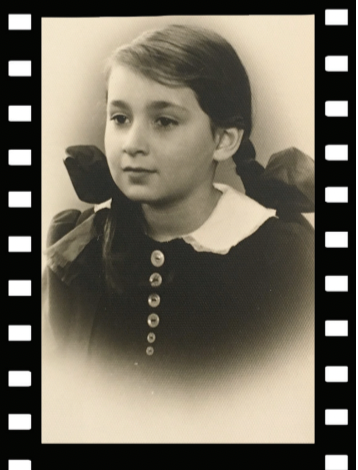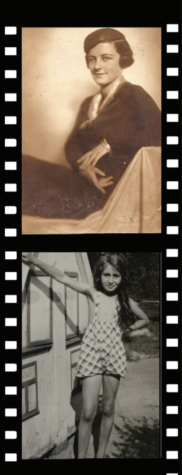Remembrance
Members of the school community discuss Holocaust Remembrance Day and the Holocaust education curriculum at the school.

Printed with Permission from Eve Levy and Joey Schoenberg. Illustration by Alexa Druyanoff.
Holocaust survivor Lilian Trilling, pictured above, turned 90 years old this year. Her story was documented in the school’s Righteous Converstations Project.
January 19, 2022
Flipping through the pages of her 10th grade Advanced Placement (AP) European History textbook, Ava Weinrot ’23 said she searched for something more extensive than the half-page of reading assigned on the Holocaust. Walking into class the next day, Weinrot hoped her teacher would hold an in-depth lecture to supplement the unsatisfactory reading but said she was shocked by the brief class discussion that only lasted 10 minutes.
Weinrot said she feels the Holocaust is often overlooked in discussions, and she said she views recognizing International Holocaust Remembrance Day as a necessary step toward improving awareness on the topic.
“Holocaust Remembrance Day is incredibly important to learn about and reflect upon,” Weinrot said. “We spend time talking about other significant days like Martin Luther King Jr. Day, which is equally important, but the Holocaust is always something glazed over. That needs to stop.”
The United Nations established International Holocaust Remembrance Day in 2005. Observed annually Jan. 27, the memorial highlights the genocide of the Jewish people by the Nazi regime during World War II.
History Teacher Dror Yaron said the United Nations chose Jan. 27 as the date of the holiday because the Soviet Union liberated the Auschwitz concentration camp on Jan. 27, 1945.
“They picked this date [because it] was the day that the Red Army the Soviet Union liberated Auschwitz, which was the epitome of Nazi death concentration camps,” Yaron said.
Weinrot, who attended a Jewish elementary school, said her elementary school provided her with a thorough education of the Holocaust. But she has not recently had an in-depth discussion of the topic beyond the broader themes and consequences of World War II.
“Something I expected we would dive into [in AP European History] was the Holocaust, but we never did,” Weinrot said. “I remember spending more time reading and discussing the political aspects of the war rather than [studying the subject] in great depth.”
Sixty-three percent of 11,000 Millennials and Generation Z survey respondents did not know the number of Jewish people murdered in the Holocaust, and over half of respondents believed the total number of deaths to be under two million, according to NBC News. The same survey showed that 90% of the young adults surveyed believe the Holocaust occurred while 11% of respondents think Jewish people caused the Holocaust.
Joey Schoenberg ’22 said these misconceptions exist largely because of a general lack of Holocaust education. He said he believes the school fails to fully teach the specifics of the Holocaust.
“[The school] has major work to do when it comes to Holocaust curriculum,” Schoenberg said. “I only learned about the Holocaust at [the school] again for a couple days throughout my experience, which is unacceptable. Most of the time we learned about the history around the Holocaust, but very rarely what happened during [it].”
Catherine Cho ’23 said her World and Europe II history class watched a video describing the details of the Holocaust. Cho said she does not think the school has enough Holocaust education and said her class spent a short period of time on the subject.
“[The Holocaust] was one of our last units,” Cho said. “Besides a video emphasizing the severity of the war, we went through that unit fairly quickly and it was not really a big part of our final either. We only spent one day on it and I don’t think that was enough considering how intense that entire situation was.”
Senior Prefect Jack Coleman ’22 said he believes the school has a responsibility to teach the Holocaust as a means of prevention and to learn about the impact of the event.
“Holocaust Remembrance Day should be as much a day of mourning [and] remembering as it should be a day of learning,” Coleman said. “I believe that remembering and mourning the Holocaust is the best prevention against another act like it. It’s also just a good thing to know about as a world citizen because it really has had tremendous impacts throughout the world, probably foremost being the creation of the state of Israel. Absolutely, 100% it should be taught in history and English class as well as commemorated by the entire school.”
Egosasere Asemota ’22 said his senior year elective class serves as a starting point to broaden his understanding of the Holocaust and further develop his awareness surrounding genocides throughout history.
“I would say the first in-depth Holocaust class I ever had at [the school] was this year in my class called [Human Conflict: From Intolerance to Genocide],” Asemota said. “It was the first class I had that taught the true violence and atrocities that happened and just how systemic it was. I can say I do feel like I understand the Holocaust in a way I hadn’t before because of this class, but I did feel like I had to do my own research.”
Asemota said acknowledging Holocaust Remembrance Day serves to prevent future genocides and that the Holocaust affects everyone, regardless of their religious beliefs or background.
“The significance of Holocaust Remembrance Day is to remember the humanity and the lives of people lost and to make sure this never happens again,” Asemota said. “It’s genocide prevention, and it’s to educate people on how easily genocides can occur and how easy it is for people to hide and ignore them. The Holocaust has an effect on people who are still alive, [and] it’s important that it should be brought up at least in history classes.”
World Language Teacher Simona Ghirlanda said in addition to lighting a candle on Holocaust Remembrance Day, she shows her Beginning Italian Language and Culture class the Italian Holocaust movie “La Vita é Bella.”
“I show [‘La Vita é Bella’] because I care about the remembrance of the Holocaust,” Ghirlanda said. “It is shown in all elementary schools in Italy because it is a way of presenting the Holocaust to children without scaring them. It is so self-censored and delicate that the kids cannot get scared, but they can become intrigued and go to their parents or teachers and ask ‘Is this a true story? What happened?’”
Ghirlanda said she is afraid that Holocaust Remembrance Day does not translate into consistent knowledge and acknowledgment of the Holocaust.
“My fear is that when it comes to [the Holocaust], people tend to think, ‘It was half a century ago. Let’s get over it,’” Ghirlanda said. “That is the most common attitude when people are not sensitive to it because they think it is gone [and it will continue] if it is not supported by ongoing education on the Holocaust and on all genocides which are happening as we speak.”
Head of Diversity Equity and Inclusion Janine Jones said the school is considering a partnership with the Shoah Foundation, a University of Southern California nonprofit organization that creates videos of interviews with survivors and Holocaust witnesses and other genocides. She said they hope such a partnership will offer students a greater education about the Holocaust and modern antisemitism.
“We are ready for more [Holocaust education],” Jones said. “I don’t think [the school] has done anything wrong. I just think we could stand to improve in that area. I think folks are ready. Teachers are ready to add more [to the curricula].”
Associate Head of School Laura Ross said the school introduces the topic to all seventh graders requiring that they read the book “The Girl in the Blue Coat” by Monica Hesse and said the ninth grade curriculum has been recently modified to include more Jewish voices and experiences. She said the Holocaust curriculum in the 10th grade The Rise of the Modern World class is currently being expanded.
“I am glad it is part of the required curriculum on both campuses and that we are growing our courses in this area,” Ross said. “A new elective [was] just approved in the Kutler Center on arts and the Holocaust to complement other existing elective courses such as ‘From Intolerance to Genocide.’ [But] I am sure we could always do more.”
While she emphasized the responsibility of the classroom in Holocaust education, Ross said it is also important
 for students to educate their peers about the Holocaust.
for students to educate their peers about the Holocaust.
“It is critical that student groups continue to work in partnership with the school to educate their peers to complement what is in the required and elective curriculum,” Ross said.
Jones said she is pleased that student groups are working to educate the community, but she said peer-to-peer education should only supplement teachers’ lessons.
“I have been very happy with our Jewish Club at the Upper School specifically, and how they have decided to gather and educate the community,” Jones said. “I firmly believe that it is not up to the students to teach, [but] I think it is up to the students to be able to celebrate and share their identity with other members of the [school] community. I think that we’re developing in this space.”
Yaron also co-founded The Righteous Conversations Project—an organization that connects students with Holocaust survivors—with students, parents and faculty in 2011. He said it is important for students to learn about the Holocaust itself, he said they must also learn about its context in order to understand genocide.
“You can’t study the Holocaust in its own vacuum,” Yaron said. “You need to intersperse Jewish history, the Jewish narrative [and] the Jewish story, since time immemorial. The Holocaust should be front and center as the model of extrapolating what genocide is.”



























